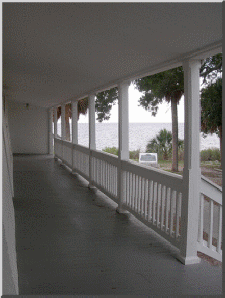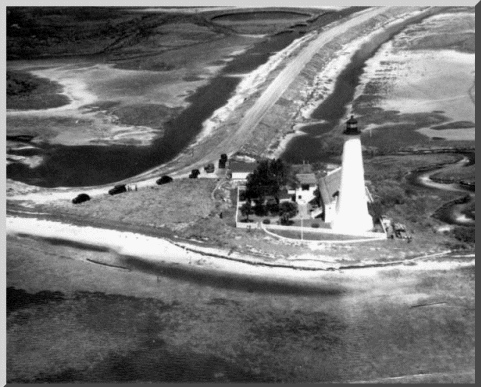St. Marks Lighthouse,
Florida
St. Marks National Wildlife Refuge
St. Marks Lighthouse is the only lighthouse in Florida with wooden stairs. The stairs are connected to a large wooden pole (it looks almost like a ship's mast) that stands in the center of the tower. Close examination of the stairs and center post shows that the stairs are attached by nails. A rope handrail was provided for use on the outside of the tower. The windows in the tower are square. They are protected with stout wooden shutters. There is a small watch room landing at the top of the wooden stairs. From the watch room to the lantern room, a short flight of narrow metal stairs leads up to a small metal trap door.
The 2,000 candlepower flashing light is visible for 15 miles, shining from the top of the white conical tower, 82 feet above the water, and 80 feet above the ground. It is located on the North side of Apalachee Bay, on the east side of the entrance to the St. Marks River.
Historic Timeline
- 1818 - Andrew Jackson captured the area around St. Marks from the Spanish, and three years later control of Florida was officially transferred from Spain to the United States.
- 1828 - William P. Duval, who succeeded Andrew Jackson as Governor of the Florida Territory, encouraged Joseph M. White, a territorial delegate to Congress, to petition for the construction of a lighthouse at St. Marks. White contacted the chair of the Senate Committee on Commerce with the plea, and on May 23, 1828, an act appropriating $6,000 for the construction of the St. Marks Lighthouse was passed.
- 1830 - The contract for the lighthouse was awarded to Winslow Lewis, and under his direction Benjamin Beal and Jairus Thayer constructed a tower at a cost of $11,765. The Collector of Customs for the District of Magnolia refused to accept the lighthouse as completed in March, 1830 and charged the builders with deliberate fraud against the United States Government. Arbitrators were appointed to examine the lighthouse, and the walls were found to be hollow instead of solid as called for in the contract.
- 1831 - The tower was rebuilt by Calvin Knowlton, Lewis’ partner. The reconstruction was completed January 29, 1831. Samuel Crosby was appointed the first keeper January 18, 1831, and entered duty in the middle of February, 1831 assuming responsibility for the tower’s many whale-oil lamps. Paid $400/year, later (1835) $500/year.
- 1835 - Under the 1832 Treaty of Payne's Landing, Florida’s Seminole Indians were to relocate west of the Mississippi River by 1835. However, when 1835 arrived, the Indians refused to leave, and the Second Seminole Indian War, which would last for seven years, erupted. During the first two years of the war, the lighthouses at Mosquito Inlet and Cape Florida were attacked. Fearing for the safety of his family, Keeper Crosby requested that a detachment of soldiers be stationed near the St. Marks Lighthouse. His request was denied. Crosby then asked for an escape boat that he could use in case of an attack, but again his petition was not granted. Fortunately, no attack was made on the St. Marks Lighthouse during Crosby’s tenure.
- 1839 Samuel Crosby's tenure as lighthouse keeper ended (Died), followed by Benjamin Metcalf. Paid $500/year.
- 1841 - Benjamin Metcalf's tenure as lighthouse keeper ended, followed by John P. Hungerford. Paid $450/year.
- 1842 - The St. Marks Lighthouse was constantly battered by storms and hurricanes. The land protecting the lighthouse from the Gulf was shrinking. By 1842, erosion was threatening the tower, and a new lighthouse was erected farther inland. The third St. Marks Lighthouse, which still stands today, rests on a base of limestone rocks taken from Fort San Marcos de Apalache and originally rose to a height of 65 feet. The stout walls are four-feet-thick at the bottom, and taper to a thickness of 18 inches up top. The new tower was built by Calvin Knowlton.
- 1843 - The sturdy construction saved the lives of Keeper Hungerford and his family, when a hurricane struck in September 17, 1843, by escaping to the attic. Fifteen others in the dwelling drowned. The hurricane and accompanying tidal wave destroyed the nearby town of Port Leon, and inflicted substantial damage on St. Marks farther upriver. As a result of damage done by the hurricane on September 17, a contract for a new keeper's dwelling was made with David Carey of Fall River, Massachusetts.
- 1844 - A contract for a sea wall was given to Francis A. Gibbons, of Baltimore, Maryland. Capt. John P. Hungerford's tenure as lighthouse keeper ended, followed by Needham Dudley. Paid $450/year.
- 1845 - Florida became a state.
- 1850 - Needham Dudley's tenure as lighthouse keeper ended when he died, followed by his wife Ann Dudley, who became the first woman light keeper at St. Marks. Paid $450/year. Her son (B: 1794) lived at the lighthouse and was listed as a laborer.
- 1851 - A second powerful hurricane struck in 1851, but again the tower withstood the blast remarkably well. The dwelling, however, was damaged. Ann Dudley lost almost all her worldly possessions totaling around $1,100. Her petition to Congress for compensation went unheeded. It destroyed the 160 foot long sea wall, six feet thick and ten feet high that had been built in 1844.
- 1854 - The lighthouse keeper's dwelling was replaced and a new breakwater was also constructed. Ann Dudley's tenure as lighthouse keeper ended, replaced by John J Alien, Aug 2, 1854. Paid $450/year.
- 1859 - Keeper John J Alien resigned Sep 20, 1859. R. H. Alexander became keeper Sep 20, 1859 and resigned Oct 27, 1859. William Blythe became keeper.
- 1860 - William Blythe's tenure ended Aug 20, 1860. David Kennedy became keeper Aug 28, 1860 a position he held before, during, and after the Civil War. Paid $450/year, later $600.
- 1862 - Nature had taken its shot at the lighthouse, and man was next. Before the Civil War reached St. Marks, the customs collector had removed all valuable items from the lighthouse. The dwelling and tower were used by both sides during the conflict. Confederate forces initially used the sturdy dwelling as a barracks and a fortress, while the tower served as a lookout. The lighthouse was bombarded by Union ships on June 15, 1862.
- 1863 - Union sailors returned and burned the wooden steps in the tower, to prevent the Confederates from reaching the top to spy on their activities.
- 1865 - When Union forces landed near the lighthouse in 1865 to march on Tallahassee, they discovered that the retreating Confederates had set off multiple charges in holes they had drilled in the tower’s foundation. One blast tore an eight-foot-tall hole in one side of the tower, while other blasts succeeded in only dislodging several outer layers of brick from the tower. In March 1865 a fleet of 16 ships landed around 1,000 Union troops near the lighthouse. Their defeat at Natural Bridge on March 6 kept Tallahassee from being occupied by the Union forces during the war.
- 1866 - After the end of the conflict, the tower was repaired between September and December of 1866.
- 1867 - The lighthouse received a new fourth-order Fresnel lens, which is still in place today. It was first lit by Keeper David Kennedy on January 7, 1867. James M Kennedy, Asst. Keeper, Sep 7, 1867.
- 1873 - Another hurricane forced the family into the tower where they survived the night. Later repairs were undertaken to the house and tower and the porch, still extant, was added.
- 1875 - James M Kennedy removed as Asst. Keeper.
- 1880 - Mark Richardson replace David Kennedy as Keeper Jan 29, 1880. He was removed May 12 1880. James H Breen became Keeper Jun 22, 1880. Paid $640/year.
- 1881 - James H Breen was removed as Keeper Jul 23, 1881. George H Gibson became Keeper Feb 1, 1881. Paid $640/year.
- 1883 - The tower was extended an additional ten feet, raising its focal plane to roughly 80 feet.
- 1892 - Light keeper George Gibson transferred to Northwest Passage and was replaced by Charles O. Fine Apr 14, 1892. Paid $600/year.
- 1904 - Charles Fine died in 1904 and his wife Sarah became the second woman light keeper at St. Marks on Sep 14, 1904. Paid $600/year.
- 1910 - J. M. Ladd became Keeper Dec 14, 1810. Paid $600/year.
- 1916 - One of Sarah Fine's daughters, Lela Fine was born there, married there and lived most of her life there after her husband, John Young Gresham, became keeper in 1916. During Gresham’s tenure a cistern, kitchen, outhouse, picket fence, boathouse and dock, and a maintenance building were added. Gresham would serve more years at the lighthouse than any other keeper. The Gresham children were raised in relative isolation at the lighthouse, and a private schoolteacher lived with the family to provide a formal education.
- 1931 - During the Gresham's service, the area around the lighthouse was incorporated into the St. Marks National Wildlife Refuge. The refuge encompasses some 68,000 acres,
which serve as wintering habitat for migratory birds. The road was built to the lighthouse.
- 1939 - The Coast Guard assumed responsibility for the nation’s lighthouses.
- 1957 - His son, Alton Gresham succeeded him in 1957 and so became the last light keeper at St. Marks.
- 1960 - The light was automated in 1960.
- 1974 - The St. Marks Lighthouse was listed on the National Register of Historic Places.
- 2000 - The Coast Guard spent $150,000 to repair and stabilize the lighthouse before turning it over to Florida's Department of Natural Resources.
|
|
|
|
|
|
|
|
|
|
|
|
|
|
|
|
|
|
|
|
|
|
|
|
|
|
|
Lighthouse Facts
Civil War Notes
Characteristics: Occulting white light every four seconds (electric flasher)
Height: 88 feet, 85 steps
DayMark: Whitewashed conical brick tower with a black lantern
History: Constructed 1829-1830, 1842. First Lighted 1831, 1842
On National Register Listing
Lens: Original, Fifteen Lewis Argand lamps with fourteen-inch reflectors; Winslow Lewis
(1831). Present: Forth-order fixed Fresnel lens; Henry-Lepaute (1867). Focal Plane: 82
feet.
Construction: Architect Winslow Lewis. Builder: Benjamin Beal and Jairus Thayer (first tower)
Calvin Knowlton (second and third towers). Conical brick tower constructed of brick and
iron.
Other Buildings::
Coordinates: 30 04 18 N
84 10 48 W
Operated by: United States Coast Guard & St. Marks National Wildlife Refuge
Visit Status: Grounds only, house and tower open for tours on Florida Lighthouse Day
Days Open: Refuge Open Daily
Facilities: None, no handicap access
Hours Open: Refuge is open during daylight hours
Visitor Info: Grounds only, access through St. Marks National Wildlife Refuge, keeper house and
tower open for tours during special events










